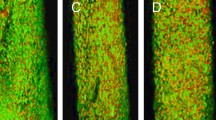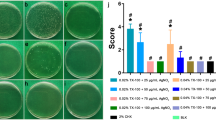Abstract
This study aimed to compare the cytotoxicity and antimicrobial efficacy of 2.5% NaOCl combined with chitosan or propolis nanoparticles at different concentrations. Nanoparticles were prepared and characterized by field emission scanning electron microscopy and Fourier transform infrared analysis. The nanoparticles were divided into different concentrations (0.625, 1, and 3 mg/mL chitosan and 4, 5, and 5.5 mg/mL propolis) and combined with 2.5% sodium hypochlorite. Antibacterial activity was tested using agar well diffusion assay with Enterococcus faecalis biofilm generated on cellulose nitrate membrane filters after overnight incubation at 37 °C. Two-way analysis of variance followed by Bonferroni post hoc test was used to evaluate reduction in CFUs among all groups, and P < 0.05 was set as the reference for statistically significant results. Cytotoxicity was measured after 24 h by MTT assay 3-(4,5-dimethylthiazol-2-yl)-2,5-diphenyltetrazolium bromide, and genotoxicity was tested by alkaline single-cell gel electrophoresis (comet assay) to measure DNA damage. The combination of chitosan or propolis nanoparticles of different concentrations with 2.5% sodium hypochlorite showed high antibacterial activity (P < 0.01). Cytotoxicity was improved when 2.5% sodium hypochlorite was mixed with 1 and 3 mg of chitosan nanoparticles or 4, 5, and 5.5 mg of propolis nanoparticles, and the difference was highly significant(P < 0.01). The addition of nanoparticles improves the antibacterial activity and cytotoxic effect of NaOCl. This new irrigant can be used in endodontic treatment given its safety and effectiveness against E. faecalis.













Similar content being viewed by others
Data Availability
The data used to support this study are available from the corresponding author upon request.
References
Zehnder, M. (2006). Root canal irrigants. Journal of Endodontia, 32(5), 389–398. https://doi.org/10.1016/j.joen.2005.09.014
Ribeiro, D. A., Yujra, V. Q., Moura, C. F., Handan, B. A., Viana, M. B., Yamauchi, L. Y., et al. (2017). Genotoxicity induced by dental materials: A comprehensive review. Anticancer Research, 37(8), 4017–4024. https://doi.org/10.21873/anticanres.11786
Sundqvist, G. (1992). “Ecology of the root canal flora,” Journal of Endodontics, 18(9), 427–430. es. 2017 Aug;37(8):4017–24. https://doi.org/10.21873/anticanres.11786
Parolia, A., Kumar, H., Ramamurthy, S., Madheswaran, T., Davamani, F., Pichika, M. R., Mak, K.-K., Fawzy, A. S., Daood, U., & Pau, A. (2021). Effect of propolis nanoparticles against Enterococcus faecalis biofilm in the root canal. Journal of Molecules, 26(3), 715.
Al-Jobory, A. I., Mahdee, A. F., Alhashimi, R. A., & Suliman, S. A. (2021). Immediate and delay antimicrobial activity of three disinfection solutions on gutta-percha cones as routine chair-side procedure. International Medical Journal, 28(1), 3–5.
Chang, Y. C., Huang, F. M., Tai, K. W., & Chou, M. Y. (2001). The effect of sodium hypochlorite and chlorhexidine on cultured human periodontal ligament cells. Oral Surgery, Oral Medicine, Oral Pathology, Oral Radiology, and Endodontology, 92(4), 446–450.
Wali, A. T., & Alqayim, M. A. J. (2019). Biosynthesis, characterization and bioactivity of selenium nanoparticles synthesized by propolis. The Iraqi Journal of Veterinary Medicine, 43(1), 197–209.
Al-Ogaidi, I. A. Z. (2021). Improving oral intake of essential oil blends using a novel formulation of biodegradable chitosan/lecithin nanoparticles. Iraqi Journal of Science, 62(9), 2906–2914.
Jaiswal, N., Sinha, D. J, Singh, U. P., Singh, K., Jandial, U. A., Goel, S. (2017). Evaluation of antibacterial efficacy of chitosan, chlorhexidine, propolis and sodium hypochlorite on Enterococcus faecalis biofilm: An in vitro study. Journal of Clinical and Experimental Dentistry, 9(9).
Bangun, H., Tandiono, S., Arianto, A. (2018). Preparation and evaluation of chitosan-tripolyphosphate nanoparticles suspension as an antibacterial agent. Journal of Applied Pharmaceutical Science, 8(12), 147–156. http://www.japsonline.com
Yusof, N., et al. (2020). Ultrasound- assisted extraction propolis and its kinetic study. IOP Conference Series: Materials Science and Engineering, 736, 022089.
Díaz-Hernández, A., Gracida, J., García-Almendárez, B. E., Regalado, C., Núñez, R., Amaro-Reyes A. Characterization of magnetic nanoparticles coated with chitosan: A potential approach for enzyme immobilization. 2018, 9468574. https://doi.org/10.1155/2018/9468574
Tsai, T.-H., Tsai, T.-H., Chien, Y.-C., Lee, C.-W., & Tsai, P.-J. (2008). In vitro antimicrobial activities against cariogenic streptococci and their antioxidant capacities: A comparative study of green tea versus different herbs. Food Chemistry, 110, 859–864.
Prakatthagomol, W., Sirithunyalug, J., & Okonogi, S. (2012). Comparison of antibacterial activity against food-borne bacteria of Alpinia galanga, Curcuma longa and Zingiber cassumunar. Chiang Mai University Journal of Natural Sciences, 11, 177–185.
Jihad, M. A., Noori, F., Jabir, M. S., Albukhaty, S., AlMalki, F. A., & Alyamani, A. A. (2021). Polyethylene glycol functionalized graphene oxide nanoparticles loaded with Nigella sativa extract: A smart antibacterial therapeutic drug delivery system. Molecules, 26(11), 3067.
Dhopavkar, V. V., et al. (2021). Comparative evaluation of cytotoxic and genotoxic effects of three resin-based sealers by 3, (4,5-dimethylthiazol-2-yl)-2,5-diphenyltetrazolium bromide assay and comet assay - an in vitro study. Contemp Clin Dent, 12(4), 376–382.
Ali, S. H., & Jafar, Z. J. (2022). In vitro cytotoxic effect of Annona squamosa pulp extract as a mouthwash for children on human normal cell line. Journal of Baghdad College of Dentistry, 34(1), 60. ISSN (P): 1817-1869, ISSN (E): 2311-5270.
Yilmaz, S., et al. (2020). Calcium hypochlorite on mouse embryonic fibroblast cells (NIH3T3) in vitro cytotoxicity and genotoxicity: MTT and comet assay. Molecular Biology Reports, 47(7), 5377–5383.
Guzel, D., et al. (2023). Genotoxic potential of different nano-silver halides in cultured human lymphocyte cells. Drug and Chemical Toxicology, 46(4), 768–780.
Giardino, L., Ambu, E., Savoldi, E., Rimondini, R., Cassanelli, C., & Debbia, U. A. (2007). Comparative evaluation of antimicrobial efficacy of sodium hypochlorite, MTAD, and tetraclean against Enterococcus faecalis biofilm. Journal of Endodontics, 33, 852.
Rajachar, P. B., Vidhya, M. S., Karale, R., Govindaraju, V. K., Shetty, N. K. (2021). Evaluation of free available chlorine of sodium hypochlorite when admixed with 0.2% chitosan: A preliminary study. The Journal of Contemporary Dental Practice, 22(10).
Hegazi, A. G., El-Houssiny, A. S, Fouad, E. A. (2019). Egyptian propolis 14: Potential antibacterial activity of propolis-encapsulated alginate nanoparticles against different pathogenic bacteria strains. Advances in Natural Sciences: Nanoscience and Nanotechnology, 10(4), id.045019.
Aliasghari, A., Khorasgani, M. R., Vaezifar, S., Rahimi, F., Younesi, H., Khoroushi, M. (2016). Evaluation of antibacterial efficiency of chitosan and chitosan nanoparticles on cariogenic streptococci: An in vitro study. Iranian Journal of Microbiology, 8(2), 93-.
Torres, A. R., Sandjo, L. P., Friedemann, M. T., Tomazzoli, M. M., Maraschin, M., Mello, C. F., & Santos, A. R. S. (2018). Chemical characterization, antioxidant and antimicrobial activity of propolis obtained from Melipona quadrifasciata quadrifasciata and Tetragonisca angustula stingless bees. Brazilian Journal of Medical and Biological Research, 51, 1–10. https://doi.org/10.1590/1414-431X20187118
Park, Y. K., Alencar, S. M., & Aguiar, C. L. (2002). Botanical origin and chemical composition of Brazilian propolis. Journal of Agricultural and Food Chemistry, 50, 2502–2506.
Al-Qathami, H., & Al-Madi, E. (2003). Comparison of sodium hypochlorite, propolis and saline as root canal irrigants: A pilot study. The Saudi Dental Journal, 5, 100–2.
Abu Al-timan, J. A., Al-Huwaizi, H., & Abed, H. (2020). Evaluating the effect of adding chitosan nanoparticles on the disinfection properties of Glyde material: An in vitro study. Research Journal of Pharmacy and Technology, 13(1), 255.
Jihad, R., & Al-Huwaizi, H. (2020). Antimicrobial evaluation for novel solution of iron oxide nanoparticles functionalized with glycine and coated by chitosan as root canal final irrigation, Rafid J. Al –Badr et al / Antimicrobial evaluation for novel solution of iron oxide nano particles functionalized with glycine and coated by chitosan as root canal final irrigation. Systematic Review Pharmacy, 11(6), 633–642.
Abidin, T., Susilo, D., & Gani, B. A. (2022). The effectiveness of nano-chitosan high molecular 0.2% as irrigant agent against Enterococcus faecalis with passive ultrasonic irrigant. Journal of Conservative Dentistry, 25(1), 37–41.
Aydin, Z. U., Akpinar, K. E., Hepokur, C., & Altunba, D. (2018). Evaluation of cytoxicity of Qmix, ethylene diamintetraacetic acid and chlorhexidine on human osteoblast cell line. Cumhuriyet Dental Journal, 21(3), 202–208.
Estrela, C., Estrela, C. R., Barbin, E. L., Spanó, J. C., Marchesan, M. A., & Pécora, J. D. (2002). Mechanism of action of sodium hypochlorite. Brazilian Dental Journal, 13(2), 113–117. https://doi.org/10.1590/S0103-64402002000200007
Marins, J. S., Sassone, L. M., Fidel, S. R., & Ribeiro, D. A. (2012). In vitro genotoxicity and cytotoxicity in murine fibroblasts exposed to EDTA, NaOCl, MTAD and citric acid. Brazilian Dental Journal, 23(5), 527–533.
Al-Shaher, A., Wallace, J., Agarwal, S., Bretz, W., & Baugh, D. (2004). Effect of propolis on human fibroblasts from the pulp and periodontal ligament. Journal of Endodontia, 30(5), 359–361. https://doi.org/10.1097/00004770-200405000-00012
Aliyazicioglu, Y., Demir, S., Turan, I., Cakiroglu, T. N., Akalin, I., Deger, O., et al. (2011). Preventive and protective effects of Turkish propolis on H2O2-induced DNA damage in foreskin fibroblast cell lines. Acta Biologica Hungarica, 62(4), 388–96. https://doi.org/10.1556/ABiol.62.2011.4.5
Montoro, A., Barquinero, J., Almonacid, M., Montoro, A., Sebastià, N., Verdú, G., et al. (2010). Concentration-dependent protection by ethanol extract of propolis against γ-ray-induced chromosome damage in human blood lymphocytes. Journal of Evidence-Based Complementary and Alternative Medicine, 2011, 174853. https://doi.org/10.1155/2011/174853
Santos, G. S., Tsutsumi, S., Vieira, D. P., Bartolini, P., & Okazaki, K. (2014). Effect of Brazilian propolis (AF-08) on genotoxicity, cytotoxicity and clonogenic death of Chinese hamster ovary (CHO-K1) cells irradiated with (60)Co gamma-radiation. Mutation Research/Genetic Toxicology and Environmental Mutagenesis, 762, 17–23. https://doi.org/10.1016/j.mrgentox.2013.11.004
Ibrahim, A., Moodley, D., Uche, C., Maboza, E., Olivier, A., & Petrik, L. (2021). Antimicrobial and cytotoxic activity of electrosprayed chitosan nanoparticles against endodontic pathogens and Balb/c 3T3 fibroblast cells. Scientific Reports, 11, 24487. https://doi.org/10.1038/s41598-021-04322-4
Gul, S., Savsar, A., & Tayfa, Z. (2009). Cytotoxic and genotoxic effects of sodium hypochlorite on human peripheral lymphocytes in vitro. Cytotechnology, 59(2), 113–119.
Fernandes, J. C., Eaton, P., Nascimento, H., Belo, L., Rocha, S., Vitorin, R., et al. (2008). Effects of chitooligosaccharides on human red blood cell morphology and membrane protein structure. Biomacromolecules, 9(12), 3346–3352. https://doi.org/10.1021/bm800622f
Wiegand, C., Winter, D., & Hipler, U. C. (2010). Molecular-weight dependent toxic effects of chitosans on the human keratinocyte cell line HaCaT. Skin Pharmacol Physiol., 23(3), 164–170. https://doi.org/10.1159/000276996
Chellat, F., Tabrizian, M., Dumitriu, S., Chornet, E., Magny, P., Rivard, C. H., et al. (2000). In vitro and in vivo biocompatibility of chitosan-xanthan polyionic complex. Journal of Biomedical Materials Research, 51(1), 107–116. https://doi.org/10.1002/(SICI)1097
Abdulkareem, A., Abdulbaqi, H., Gul, S., Milward, M., Chasib, N., & Alhashimi, R. (2022). Classic vs. novel antibacterial approaches for eradicating dental biofilm as adjunct to periodontal debridement: An evidence-based overview. Antibiotics (Basel), 11(1), 9.
Acknowledgements
All authors have contributed significantly, and all authors are in agreement with the present manuscript.
Author information
Authors and Affiliations
Contributions
All authors participated in all manuscript requirements to produce a final version of the manuscript after being read and agreed upon by everyone.
Raghad Abdulrazzaq Al-Hashimi read and review the manuscript.
Fatima Fahad do all manuscript requirement.
Zaid.R.hussien Z.H prepare the nanomaterial.
Corresponding author
Ethics declarations
Competing Interests
The authors declare no competing interests.
Research Involving Humans and Animals Statement
None.
Informed Consent
None.
Additional information
Publisher's Note
Springer Nature remains neutral with regard to jurisdictional claims in published maps and institutional affiliations.
Rights and permissions
Springer Nature or its licensor (e.g. a society or other partner) holds exclusive rights to this article under a publishing agreement with the author(s) or other rightsholder(s); author self-archiving of the accepted manuscript version of this article is solely governed by the terms of such publishing agreement and applicable law.
About this article
Cite this article
Fahad, F., Al-Hashimi, R.A. & Hussien, Z.R. The Antibacterial Efficacy and Cytotoxicity of Incorporating Nanoparticles into Sodium Hypochlorite as Irrigant Solution. BioNanoSci. (2023). https://doi.org/10.1007/s12668-023-01260-5
Accepted:
Published:
DOI: https://doi.org/10.1007/s12668-023-01260-5




